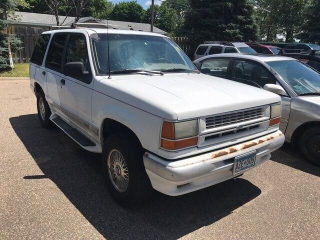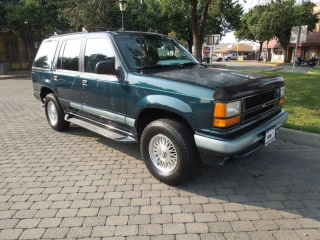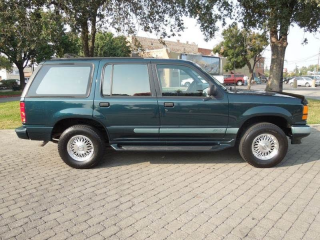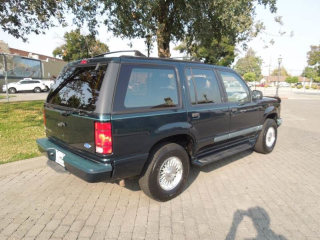The 1994 Ford Explorer, a mid-size SUV that debuted in 1990, quickly became a segment leader. It was available as a 2-door or 4-door, with popular trims like the XLT and Eddie Bauer. Its popularity stemmed from its comfortable ride, car-like handling for its class, and offering a more refined experience than traditional truck-based SUVs. It offered a blend of utility and everyday usability that resonated with families and individuals alike.
The Good
The 1994 Explorer excelled with its comfortable and quiet ride, making it a pleasant daily driver. Its approachable design and ample interior space appealed to families, while its robust V6 engine provided capable performance for most needs, offering a compelling balance of value and practicality.
The Bad
Potential buyers should be aware of possible issues with the rear differential, particularly the c-clip axle design which can lead to catastrophic failure. Transmission problems and rust, especially on the frame and body panels, are also common concerns to inspect closely.
1994 Ford Explorer: Quick Overview
- Engine Options: The 1994 Ford Explorer typically offered two primary engine choices:
- A 4.0L V6 engine
- A 5.0L V8 engine (less common, often found in specific performance variants or police interceptor models)
- Horsepower:
- The 4.0L V6 engine generally produced around 160 horsepower.
- The 5.0L V8 engine offered a higher output, typically in the range of 215 horsepower.
- Fuel Economy:
- Expect fuel economy to be in the range of 14-17 MPG city and 17-20 MPG highway for the V6 engine, depending on drivetrain (2WD/4WD) and transmission. The V8 would likely see lower figures.
- 0-60 Times:
- 0-60 mph times varied by engine and drivetrain, but a typical 4.0L V6 would be in the 9-11 second range. The V8 would be quicker.
- Towing Capacity:
- The towing capacity for the 1994 Ford Explorer was generally around 5,000 to 7,000 pounds when properly equipped with an appropriate towing package.
- Trim-Level Features: Key trims and their features often included:
- XL/Sport: Base model, typically with essential features.
- XLT: A popular mid-range trim, often including power windows, power locks, air conditioning, cruise control, and upgraded interior appointments.
- Eddie Bauer: The premium trim, featuring leather seating, woodgrain interior accents, premium audio systems, heated mirrors, and often a two-tone exterior paint scheme.
- Special Editions: Various packages and special editions could add unique badging, wheels, or content.
- XL/Sport: Base model, typically with essential features.
1994 Ford Explorer Specifications
Vehicle Information
| Year | 1994 |
| Make | Ford |
| Model | Explorer |
| Trim | - |
| Style | 2WD 4-Speed Automatic |
| Type | Sport Utility Vehicle |
| Category | Standard Sport Utility Vehicle |
Manufacturing Details
| Made In | United States |
| Manufacturing City | LOUISVILLE |
Dimensions
| Doors | 2-Door |
| Curb Weight | 4022 pounds |
| Gross Vehicle Weight Rating | 16000 pounds |
| Overall Height | 67.50 inches |
| Overall Length | 174.50 inches |
| Overall Width | 70.20 inches |
| Wheelbase Length | 102.10 inches |
| Standard Seating | 4 |
Engine & Performance
| Engine | 4.0-L V-6 OHV 12V |
| Engine Size | 4L |
| Engine Cylinders | 6 |
| Transmission | 4-Speed Automatic |
| Transmission Type | Automatic |
| Transmission Speeds | 4-Speed |
| Drivetrain | Four-Wheel Drive |
Additional Features
| Anti-Brake System | 4-Wheel ABS |
| Steering Type | Recirculating |
Pricing
| Manufacturer Suggested Retail Price (MSRP) | $23,605 |
| Invoice Price | - |
| Delivery Charges | - |
Vehicle History Report
Vehicle
Specifications
Specifications
Ownership
History
History
All History
Events
Events
NMVTIS Title
History Check
History Check
Salvage/Rebuilt
Check
Check
Accident
Check
Check
Theft
Check
Check
Open Lien
Check
Check
Past Sale
Listings
Listings
Safety
Recalls
Recalls
Odometer
Check
Check
Market Price
Analysis
Analysis
What Problems Does the 1994 Ford Explorer Have?
The 1994 Ford Explorer, while popular, is not without its known issues. A significant concern, particularly with rear-wheel-drive models equipped with the c-clip rear axle, is the potential for the axle shaft to disengage from the differential. This can lead to the loss of motive power and, in severe cases, the wheel detaching from the vehicle, posing a serious safety hazard. While the 1994 model year itself may not have had specific recalls solely for this, it's a pervasive issue within this generation of Explorers that owners should be aware of. Ford did eventually introduce a stronger axle design in later years.
Another frequently reported problem area is the transmission. Issues such as slipping gears, harsh shifting, or complete transmission failure have been noted. Regular maintenance, including fluid changes, is crucial to prolong transmission life.
Rust is also a common enemy for vehicles of this vintage. The frame rails, rocker panels, wheel wells, and the tailgate are particularly susceptible to corrosion, especially in regions with harsh winters and road salt. Thorough inspection of these areas is paramount when considering a purchase.
Cooling system components, such as radiators and water pumps, can also be a source of trouble over time. Overheating can lead to more significant engine damage. Less frequent but still reported issues include problems with the electronic 4WD system (if equipped), sensor failures, and wear and tear on suspension components like ball joints and tie rods. While not exclusive to the 1994 model year, these are recurring themes for this generation of the Ford Explorer.
Another frequently reported problem area is the transmission. Issues such as slipping gears, harsh shifting, or complete transmission failure have been noted. Regular maintenance, including fluid changes, is crucial to prolong transmission life.
Rust is also a common enemy for vehicles of this vintage. The frame rails, rocker panels, wheel wells, and the tailgate are particularly susceptible to corrosion, especially in regions with harsh winters and road salt. Thorough inspection of these areas is paramount when considering a purchase.
Cooling system components, such as radiators and water pumps, can also be a source of trouble over time. Overheating can lead to more significant engine damage. Less frequent but still reported issues include problems with the electronic 4WD system (if equipped), sensor failures, and wear and tear on suspension components like ball joints and tie rods. While not exclusive to the 1994 model year, these are recurring themes for this generation of the Ford Explorer.
How long will the 1994 Ford Explorer last?
With diligent maintenance, a 1994 Ford Explorer can realistically achieve between 200,000 to 250,000 miles or more. Many owners report reaching these figures with consistent oil changes, transmission fluid flushes, and addressing minor issues promptly. However, the long-term durability can be significantly impacted by the aforementioned weaknesses. Vehicles that have not been well-maintained, especially those with untreated rust or untreated rear axle concerns, may fail much sooner. The powertrain, particularly the V6 engine, is generally robust, but components like the transmission and cooling system can become weak points over time, often requiring costly repairs in the later stages of its service life.
What Technology & Safety Features are Included?
The 1994 Ford Explorer, being from the early to mid-1990s, offered a modest suite of technology and safety features by today's standards.
Built-in Tech and Entertainment: Standard entertainment typically consisted of an AM/FM radio with an optional cassette player. Higher trims, like the Eddie Bauer, could be optioned with a CD player, offering a more advanced audio experience for the time. Features like power windows, power door locks, and cruise control were available, particularly on mid-to-upper trims, enhancing convenience. Air conditioning was a common feature.
Driver-Assistance Features: Driver-assistance features were virtually non-existent in the modern sense. Anti-lock Braking System (ABS) was an available option on some models, providing improved braking control, especially in slippery conditions. Four-wheel drive (4WD) was also an option, enhancing capability off-road and in inclement weather, though this is more of a capability feature than driver assistance.
Safety Features: Standard safety features included seatbelts and airbags for the driver and front passenger. Side-impact door beams were designed to improve crash protection. The vehicle's larger SUV form factor offered a sense of security for many buyers.
Crash-Test Ratings: Official NHTSA crash-test data for the 1994 Ford Explorer is not as comprehensively available as for more modern vehicles. However, for similar models of its era, the Explorer generally performed adequately in frontal and side-impact tests, though it was not exceptional. Its higher center of gravity also meant it was more prone to rollovers than passenger cars, a common characteristic of SUVs from that period. The presence of ABS and airbags would have contributed positively to its safety performance. Optional features could have included a rear wiper, roof rack, and running boards.
Built-in Tech and Entertainment: Standard entertainment typically consisted of an AM/FM radio with an optional cassette player. Higher trims, like the Eddie Bauer, could be optioned with a CD player, offering a more advanced audio experience for the time. Features like power windows, power door locks, and cruise control were available, particularly on mid-to-upper trims, enhancing convenience. Air conditioning was a common feature.
Driver-Assistance Features: Driver-assistance features were virtually non-existent in the modern sense. Anti-lock Braking System (ABS) was an available option on some models, providing improved braking control, especially in slippery conditions. Four-wheel drive (4WD) was also an option, enhancing capability off-road and in inclement weather, though this is more of a capability feature than driver assistance.
Safety Features: Standard safety features included seatbelts and airbags for the driver and front passenger. Side-impact door beams were designed to improve crash protection. The vehicle's larger SUV form factor offered a sense of security for many buyers.
Crash-Test Ratings: Official NHTSA crash-test data for the 1994 Ford Explorer is not as comprehensively available as for more modern vehicles. However, for similar models of its era, the Explorer generally performed adequately in frontal and side-impact tests, though it was not exceptional. Its higher center of gravity also meant it was more prone to rollovers than passenger cars, a common characteristic of SUVs from that period. The presence of ABS and airbags would have contributed positively to its safety performance. Optional features could have included a rear wiper, roof rack, and running boards.
What Colors Options are Available?
1994 Ford Explorer Prices and Market Value
When new, the 1994 Ford Explorer had a price range that typically started in the low $20,000s for base models and could climb to the high $20,000s or even $30,000s for fully-equipped Eddie Bauer trims.
Currently, used market prices for a 1994 Ford Explorer vary significantly. Expect prices ranging from under $1,000 for vehicles needing substantial work to $3,000-$5,000 for well-maintained examples, especially desirable trims or those with lower mileage.
The Explorer has undergone significant depreciation since its launch, as is typical for vehicles of its age. Factors affecting its resale value today include its overall condition (mechanical and cosmetic), mileage, the presence of rust, the specific trim level, and whether it has the more desirable V8 engine option. A clean, rust-free example with good maintenance records will command a much higher price.
Currently, used market prices for a 1994 Ford Explorer vary significantly. Expect prices ranging from under $1,000 for vehicles needing substantial work to $3,000-$5,000 for well-maintained examples, especially desirable trims or those with lower mileage.
The Explorer has undergone significant depreciation since its launch, as is typical for vehicles of its age. Factors affecting its resale value today include its overall condition (mechanical and cosmetic), mileage, the presence of rust, the specific trim level, and whether it has the more desirable V8 engine option. A clean, rust-free example with good maintenance records will command a much higher price.
1994 Ford Explorer Cost of Ownership
Owning a 1994 Ford Explorer can be relatively economical for fuel, especially with the V6 engine, though it's not a fuel-sipper. Insurance costs are generally moderate, falling within typical rates for older SUVs. Maintenance costs are average for a vehicle of its age; regular oil changes, fluid checks, and tire rotations are standard. However, repair costs can become significant. Addressing common issues like transmission problems or potential rear axle repairs can be expensive. Long-term ownership leans towards being moderately costly, as wear-and-tear items and potential major repairs become more likely with age and mileage, making it not the most economical choice without careful budgeting for potential issues.
1994 Ford Explorer Fuel Efficiency
Fuel Type
Gasoline
Fuel Capacity
19.30 gallons
City Mileage
15 miles/gallon
Highway Mileage
20 miles/gallon
1994 Ford Explorer Safety Rating
NHTSA
IIHS
1994 Ford Explorer Warranty
Basic
Original warranty
0 months / No data
Estimated remaining
Expired
Powertrain
Original warranty
0 months / No data
Estimated remaining
Expired
Rust
Original warranty
0 months / No data
Estimated remaining
Expired
1994 Ford Explorer Insurance
Insurance for a 1994 Ford Explorer is moderately priced, reflecting its status as a Sport Utility Vehicle with strong safety ratings and
reasonable repair costs.
reasonable repair costs.
How Does the 1994 Ford Explorer Compare to Other Sport Utility Vehicle?
The 1994 Ford Explorer competed in a hot segment against rivals like the Jeep Cherokee, Chevrolet S-10 Blazer/GMC S-15 Jimmy, and the Toyota 4Runner.
Performance: The Explorer's V6 offered competitive power and a smoother on-road driving experience compared to the more utilitarian Jeep Cherokee. The optional V8 in some Explorers gave it an edge in acceleration over most four-cylinder or smaller V6 rivals.
Features: Ford's Explorer, especially in XLT and Eddie Bauer trims, was known for its more car-like interior and comfort features, often outfitting it with more amenities than the base Jeep Cherokee or the more basic S-10 Blazer. The Toyota 4Runner was a strong contender with its legendary reliability but often came with a higher price tag.
Reliability: This is where the Explorer has historically lagged behind some key rivals. While the powertrain could be robust, the known issues with the rear axle and transmission were more prevalent than in, say, the Toyota 4Runner, which is renowned for its long-term dependability. The Jeep Cherokee also had a reputation for ruggedness but could be prone to rust and its ride was less refined.
Price: The Explorer offered a compelling value proposition when new, balancing features and capability at a competitive price point. In the used market, it often remains more affordable than a comparable 4Runner, making it an attractive budget option.
Recommendations: If long-term reliability and off-road prowess are paramount, the Toyota 4Runner is a superior alternative, though likely at a higher cost. For a more rugged and simpler vehicle with a strong aftermarket, the Jeep Cherokee (XJ) is a solid choice, but expect a less comfortable ride. The Chevrolet S-10 Blazer/GMC Jimmy offers similar practicality and availability to the Explorer, often with comparable pricing, but also shares some of the same mid-90s GM mechanical quirks. Ultimately, the 1994 Explorer remains a viable option for those seeking a comfortable, affordable SUV with decent capability, provided they are aware of and can address its known weaknesses.
Performance: The Explorer's V6 offered competitive power and a smoother on-road driving experience compared to the more utilitarian Jeep Cherokee. The optional V8 in some Explorers gave it an edge in acceleration over most four-cylinder or smaller V6 rivals.
Features: Ford's Explorer, especially in XLT and Eddie Bauer trims, was known for its more car-like interior and comfort features, often outfitting it with more amenities than the base Jeep Cherokee or the more basic S-10 Blazer. The Toyota 4Runner was a strong contender with its legendary reliability but often came with a higher price tag.
Reliability: This is where the Explorer has historically lagged behind some key rivals. While the powertrain could be robust, the known issues with the rear axle and transmission were more prevalent than in, say, the Toyota 4Runner, which is renowned for its long-term dependability. The Jeep Cherokee also had a reputation for ruggedness but could be prone to rust and its ride was less refined.
Price: The Explorer offered a compelling value proposition when new, balancing features and capability at a competitive price point. In the used market, it often remains more affordable than a comparable 4Runner, making it an attractive budget option.
Recommendations: If long-term reliability and off-road prowess are paramount, the Toyota 4Runner is a superior alternative, though likely at a higher cost. For a more rugged and simpler vehicle with a strong aftermarket, the Jeep Cherokee (XJ) is a solid choice, but expect a less comfortable ride. The Chevrolet S-10 Blazer/GMC Jimmy offers similar practicality and availability to the Explorer, often with comparable pricing, but also shares some of the same mid-90s GM mechanical quirks. Ultimately, the 1994 Explorer remains a viable option for those seeking a comfortable, affordable SUV with decent capability, provided they are aware of and can address its known weaknesses.
Final Verdict: Is the 1994 Ford Explorer a Good Sport Utility Vehicle?
The 1994 Ford Explorer is ideal for budget-conscious buyers seeking a versatile SUV for light off-roading, family hauling, or general transportation that offers more space and capability than a sedan. It's worth buying cautiously as a used vehicle, particularly if found at a low price.
It is best purchased as a used vehicle, as buying new is no longer an option. Focus on well-maintained examples, ideally with documented service history. The XLT and Eddie Bauer trims offer more comfort and features. Buyers must be diligent in inspecting for rust, checking the condition of the transmission, and being aware of the potential rear axle issue. If these concerns are addressed or absent, it can be a solid, affordable choice for someone who understands its age and potential needs.
It is best purchased as a used vehicle, as buying new is no longer an option. Focus on well-maintained examples, ideally with documented service history. The XLT and Eddie Bauer trims offer more comfort and features. Buyers must be diligent in inspecting for rust, checking the condition of the transmission, and being aware of the potential rear axle issue. If these concerns are addressed or absent, it can be a solid, affordable choice for someone who understands its age and potential needs.




